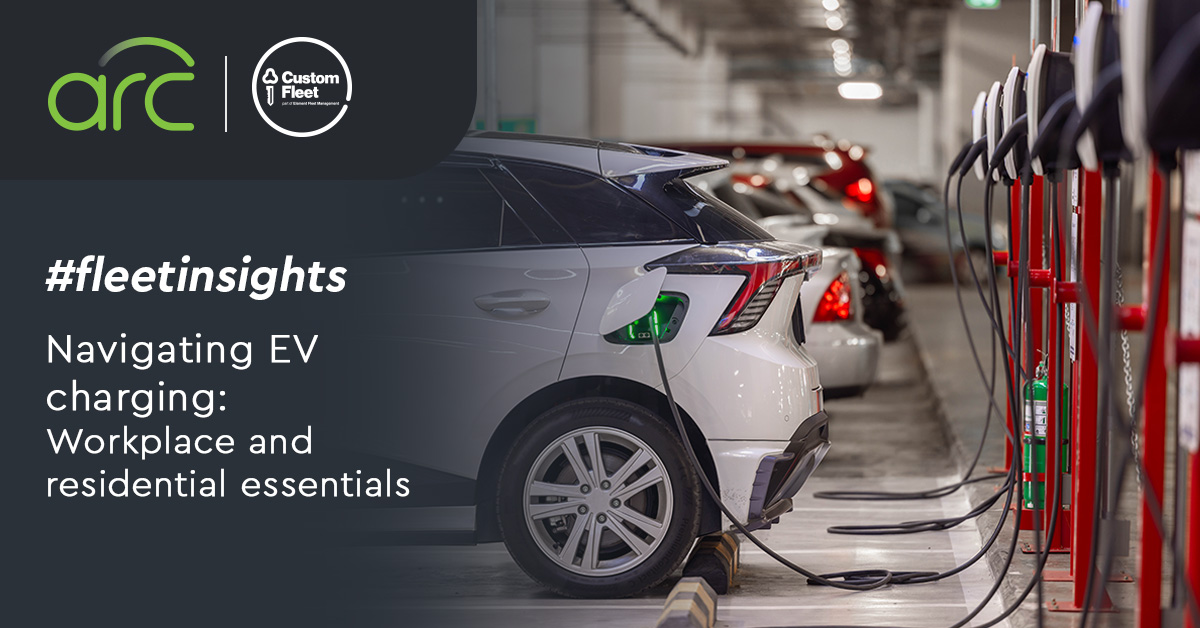23 July 2024
Navigating EV charging: Workplace and residential essentials
As the world moves towards a more sustainable future, Electric Vehicles (EVs) will play a significant role in reducing our dependence on fossil fuels.
If you're considering introducing EVs to your fleet, it's important to prepare a transition plan that’s appropriate for the needs to your fleet and your drivers, so that you’re set up for long-term success.

Based on research into charging behaviour around the world, up to 60% of charging is taking place at home and up to 30% will occur at the workplace. It’s vital that any EV transition plan addresses charging in both locations for a seamless and cost-effective solution.
Installing EV chargers in the workplace
Whether you own or lease your work premises, a thorough property assessment is important to determine electrical grid capacity and any upgrades that may be required.
Considerations include charger location, and switchboard connection points, safety and compliance, and permits. This process helps determine any upgrades needed to support EV charging stations.
When multiple chargers are installed at a single location, load management may be required.
Load management equipment works by allocating electricity to charging stations based on the site’s capacity and the number of plugged-in vehicles. The system enables the site to remain within its power limit, preventing any unexpected electrical outages.
Can you install EV chargers in a leased car park?
This is a common question for organisations looking to transition their fleets to EVs.
While obtaining written permission is needed, rental contracts often have clauses allowing for improvements to the property. You’ll need to speak to your building manager to secure the necessary approvals.
Smart chargers
Smart chargers are highly recommended in the workplace as they can be programmed to only permit authorised users to charge via an RFID card or mobile app.
A business can also schedule times, for example including during periods of low electrical usage demand when energy is cheaper or when there is higher availability of renewable energy.
Other factors to consider include:
- Assessing the number of chargers required
- Allocating EV parking spaces
- Installing signage to prevent non-EVs from occupying charging spots
Installing residential EV chargers
Depending on your fleet structure and whether your drivers need to take their vehicles home, you may need to install EV chargers at the residences of your fleet drivers.
Similar to a workplace, it’s important to start with an inspection of the electrical capacity of the home.
For rental properties, securing landlord and owners corporation approvals is crucial. Collaboration with property owners and managers ensures compliance and facilitates EV charging for fleets.
In apartments, negotiations with body corporate are necessary before installation. Due to space constraints, shared charging bays may be preferred as they offer flexibility but require cooperation between residents for timely vehicle charging.
Remote and off-the-grid properties
Charging fleets in remote and off-grid areas presents unique challenges.
Many of these properties may already have a solar panel system installed. However, the capacity of the solar installation will need to be reviewed to see if there’s sufficient excess generation to charge an EV.
Upgrading energy connections in remote regions may be expensive and time consuming.
Electrical capacity requirements
Assessing electrical capacity at any location is necessary for efficient fleet charging operations. A comprehensive evaluation may require system upgrades.
There are three charging options for EVs:
- Trickle charging via a standard household plug provides up to 20km range per hour. This method is not a long-term solution and should only be used for emergency charging. Besides being very slow, it can present risks to safety for the homeowner.
- AC dedicated wall mount chargers offer faster charging at approximately 60-80km range per hour. This is the recommended means to charge a fleet vehicle and strikes the right balance between charging speed and cost to install. Workplace and residential chargers are typically AC chargers.
- DC fast charging, available at public sites, provides about 400-500km range per hour.
Cost and reimbursements
A company may choose to cover the cost of installation and any ongoing charger expenses such as smart charging or annual inspection costs if the charger remains company property.
However, if ownership of a charger is transferred to the employee, you should seek advice on whether there is a fringe benefits tax liability created.
Fleet managers should also develop reimbursement policies for electricity usage from charging a company fleet vehicle.
Safety considerations
A dedicated charger installed by a qualified electrician is the safest and most convenient way to charge an EV.
As mentioned above, trickle chargers that can be plugged into a standard 10A domestic outlet should only be used in emergencies.
Important: If a trickle charger is being used, no additional appliances should be connected to the outlet via an extension cable or power board, to prevent overloading.
Lithium-ion batteries in devices such as e-bikes and e-scooters pose fire hazards due to overcharging, equipment failure, or damage.
Fortunately, the batteries in an EV are manufactured to much higher standards. Low risk does not mean no risk, and the Australian Building Code Board (ABCB) released guidance for building owners and developers to support them in preparing their buildings to be EV ready.
Download the ABCB EV Guidance Document June 2023 (383KB, PDF)
Arc by Custom Fleet
We're committed to promoting sustainable mobility solutions in Australia and New Zealand. If you’re considering bringing EVs into your fleet, we're here to support you every step of the way.
Ready to electrify your fleet?
Schedule an appointment with Custom Fleet to discuss EV leasing options, charging infrastructure solutions, and fleet management services tailored to your business needs.

